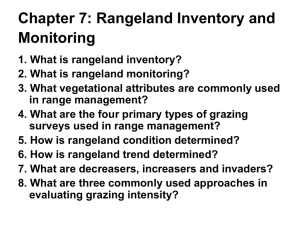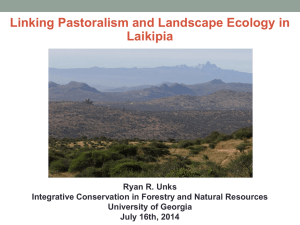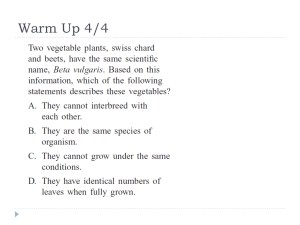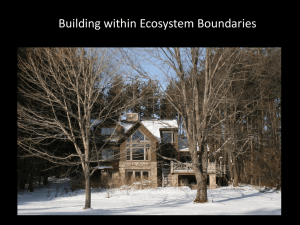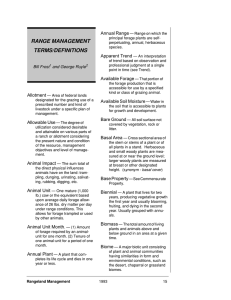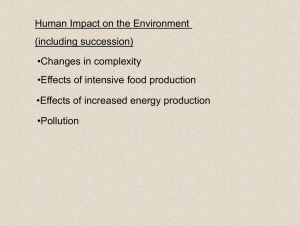Lecture 4 - College of Agricultural, Consumer and Environmental
advertisement
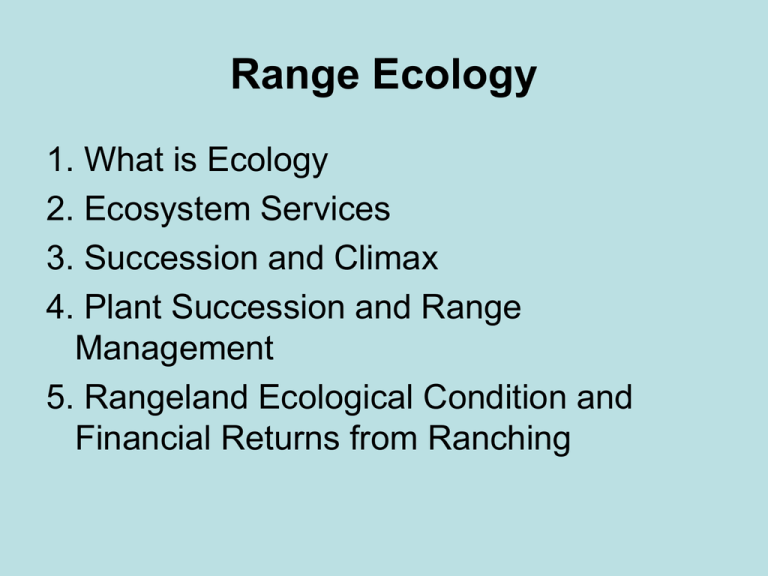
Range Ecology 1. What is Ecology 2. Ecosystem Services 3. Succession and Climax 4. Plant Succession and Range Management 5. Rangeland Ecological Condition and Financial Returns from Ranching Review Questions 1. What are positive impacts of controlled grazing on rangeland ecosystems? 2. What are the negative impacts of poorly controlled grazing on rangeland ecosystems? 3. What amount of remaining climax vegetation best optimizes multiple use demands on most western rangelands? Definitions: Ecology and Ecosystem Ecology: The study of the interrelationships between organisms and their environment. Ecosystem: An ecological system. Components of Ecosystem 1. Inorganic substances (C, N, CO2, H20, etc.) 2. Organic compounds (proteins, carbohydrates, etc) 3. Climate regime (precipitation, temperature, other physical factors) 4. Producers (autotrophic-mainly green plants) 5. Consumers (heterotrophic-animals) 6. Decomposers or reducers (bacteria, fungi, etc.) Ecosystem Services Basic processes such as maintenance of air and water quality essential to human life performed by natural or near natural landscapes (ecosystems). These Processes have generally been taken for granted by humans but their importance is increasingly being recognized as the world human population increases and the world’s natural landscapes diminish. Ecosystem Services (examples) a. Maintenance of air quality b. Maintenance of water quality c. Decomposition of waste and organic matter d. Nutrient cycling e. Pollination of plants Ecosystem Services (examples) f. Renewal of soil fertility g. Provision of genetic resources h. Natural control of pathogens and diseases i. Regulation of freshwater supplies. Ecosystems services and products 1. Clean air 2. Clean water 3. Biodiversity a. Medicine b. Agriculture c. Environmental barometer d. Pest control e. Right to live Ecosystems services and products 4. Esthetics 5. Food 6. Ozone 7. Climatic stability 8. Environmental purification 9. Plant products (non-food) 10. Animal products (non-food) Plant succession • Orderly replacement of one plant community by another. • Succession • Bare Rock Lichen/Moss/Annual Herbs/Perennial Herbs/Climax • Retrogression Five Factors Causing Soil Formation 1. Parent materials 2. Topography 3. Climate 4. Living organisms 5. Time Definitions Climax vegetation- The end point of succession, the vegetation that will maintain itself on a particular site. Primary Succession- Natural plant succession on previously unvegetated areas leading to a climax. Secondary Succession- Succession on land which previously has been occupied by more highly developed vegetation destroyed by some unusual circumstances, such as fire. Retrogression- Changes away from the climax, may be caused by fire, overgrazing, drought, volcano, etc. Effect of grazing pressure on plants groups *Unpalatable plants replace palatable plants under heavy grazing because unpalatable plants invest part of their products from photosynthesis in poison, spines, thorns, etc. This protects them from grazing. *Palatable plants replace unpalatable plants when grazing pressure is reduced to moderate or light levels because they devote their photosynthetic products to growth (roots, leaves, stems, rhizomes, stolons, seeds). Processes of primary succession 1. The development of soil from parent material 2. Increasing longevity with successional advance. 3. Replacement of species with broad ecological requirements by those occupying narrow niches complementary with other species. 4. Greater accumulation of living tissue and litter per unit area with successional advance Processes of primary succession cont. 5. Modification of microenvironmental extremes 6. Change in size of plants from small to large 7. Increase in the number of pathways of energy flow 8. More nutrients tied up in living and dead organic matter 9. Greater resistance to fluctuation in the controlling factors Some terminology Autogenic succession- Change in plant community composition that is caused by the community itself. Allogenic succession- Forces other than the community cause succession such as climatic change, grazing, fire, flood, farming, etc. Controlling factors- climate, biotic materials, geologic materials, Dependant factors – properties of micro-climate, soils, vegetation, decomposers, transformers, and reducers. Some terminology Allelopathy- chemical inhibition of a plant or group of plants by a specific plant species. Periodicity- Different plant species make peak moisture or nutrient demands at different times during the growing seasons. Stratification- The development of layers of plants with different heights Table 6.4 Grazable perennial forage production and financial returns ($/acres) for Chihuahuan Desert Cattle Ranches in New Mexico, in different ecological condition classes. Range ecological condition Climax (Excellent) Late seral (Good) Mid seral (Fair) Early seral (Poor) Forage production (lbs/ac/yr)a 764 501 210 55 Financial returns ($/ac/yr)b +3.49 +2.14 +0.67 -0.16 Source: Holechek a.Forage prod in yr of avg ppt conditions b. Avg returns per yr for 19861993 period Table 6.6 Summary of 25 studies evaluating the effects of grazing intensity on rangeland ecological condition in N America Grazing intensity % use of forage % of studies showing downward trend % of studies showing stable trend % of studies showing upward trend Heavy 51-65% 90 10 0 Moderate 40-50% 23 30 47 Light <40% 5 21 74 Source: Holechek et al. 1999 Impacts of overgrazing on the range ecosystem 1. Loss of palatable perennial plants. 2. Loss of plant cover; soil erosion. 3. Increase in poisonous plants. 4. Increased populations of rodents and jackrabbits. 5. Increase in annual forbs and grasses. Impacts of overgrazing on the range ecosystem cont. 6. Loss of springs and seeps due to reduced water infiltration. 7. Compaction of the soil. 8. Reduced quality of water in streams and ponds due to sedimentation. 9. Reduction and elimination of desirable fish and wildlife species. 10. Increased populations of undesirable insects such as grasshoppers. Possible Positive Influence of Carefully Controlled Grazing On Rangeland Ecosystem 1. Loosening of the soil surface during dry periods. 2. Removal of excessive vegetation that may negatively affect net carbohydrate fixation and increase water transpiration. 3. Incorporating mulch into the soil profile, which speeds development of humus. 4. Recycling nutrients and making some nutrients more available. 5. Maintaining an optimal leaf area index of plant tissue. Possible Positive Influence of Carefully Controlled Grazing On Rangeland Ecosystem cont. 6. Trampling seed into the ground. 7. Reducing excessive accumulations of standing dead vegetation and mulch that may chemically and physically inhibit new growth. 8. Inoculating plant parts with saliva that may stimulate plant regrowth. 9. Reducing fire, insect and rodent problems resulting from excessive accumulation of vegetation. Range indicators of overgrazing 1. Preponderance of plants of low palatability. 2. Vegetation dominated by a few species. 3. Presence of a high percentage of annual plants, particularly forbs. 4. Palatable shrubs hedged. 5. Widespread network of recently formed gullies. 6. Pedestaled plants resulting from recent removal of soil. 7. Hummocks where soil has been deposited under plants by wind. Problems with annual vegetation 1. Productivity fluctuates drastically from year to year. 2. The period when they are green and nutritious is much shorter than with perennials. 3. They are generally less palatable than perennials, there fore livestock performance, is reduced because forage intake is reduced (many annuals have no forage value) 4. Many annuals are poisonous to livestock. 5. Soil cover is generally reduced with annuals compared to perennials.



